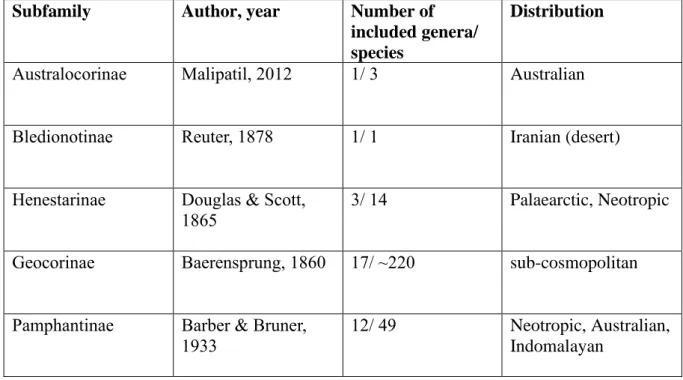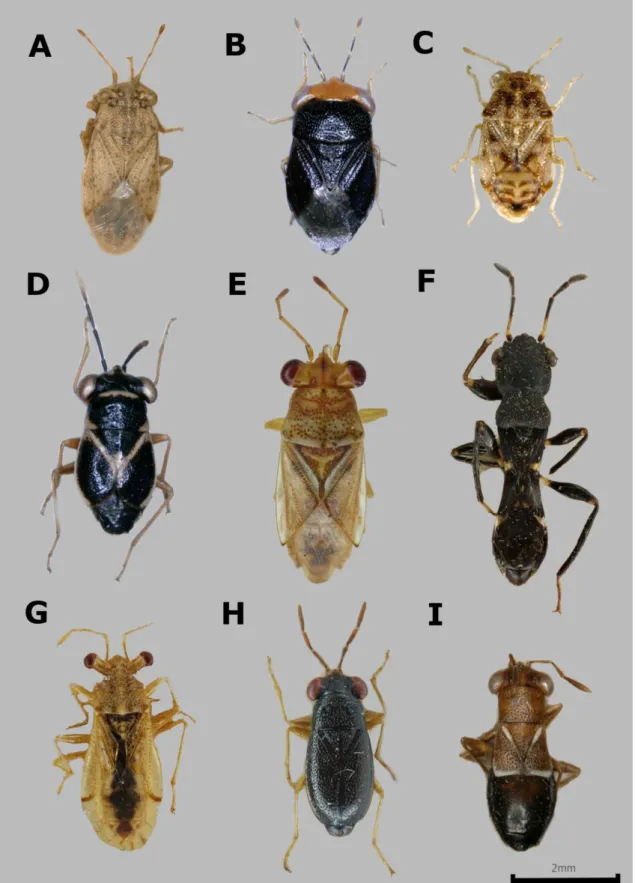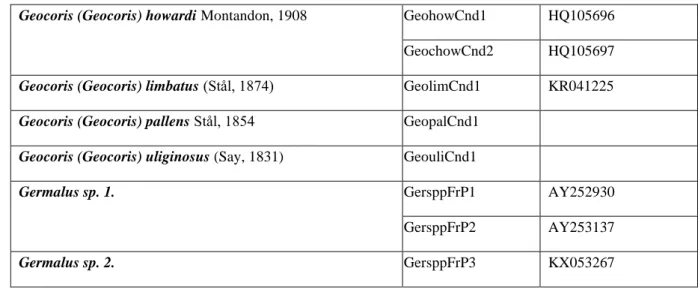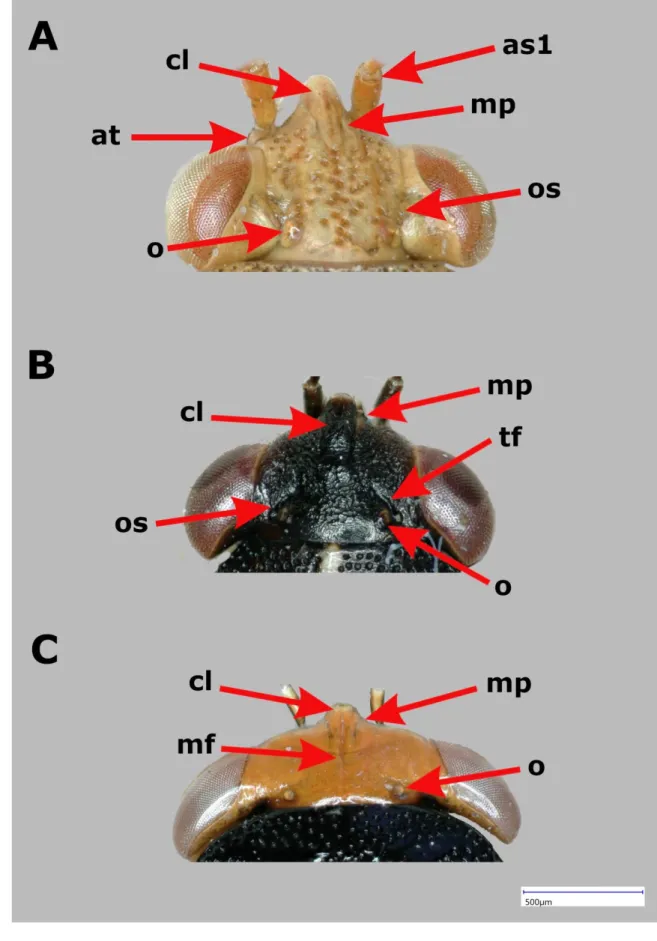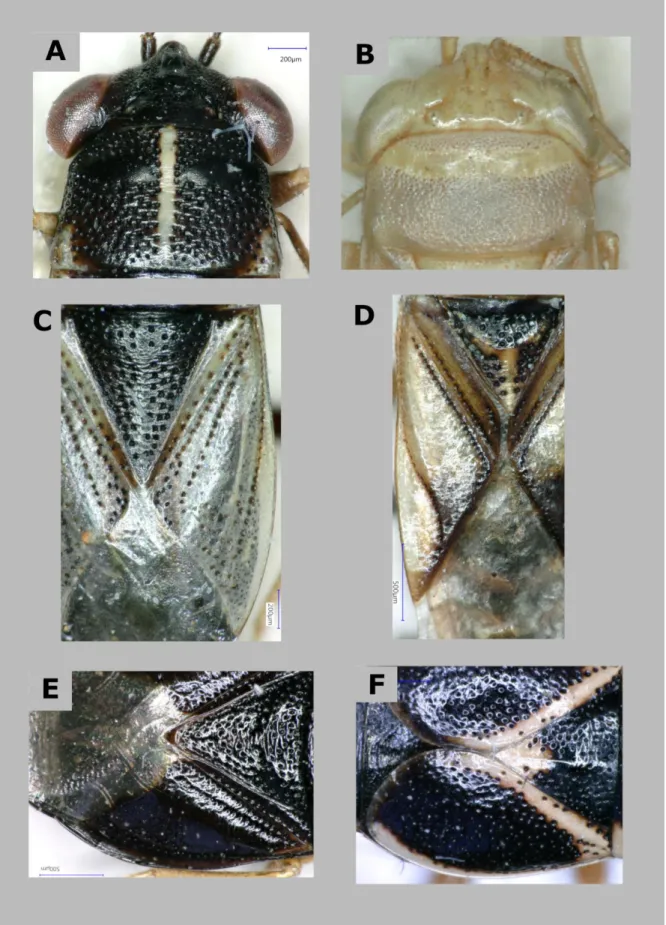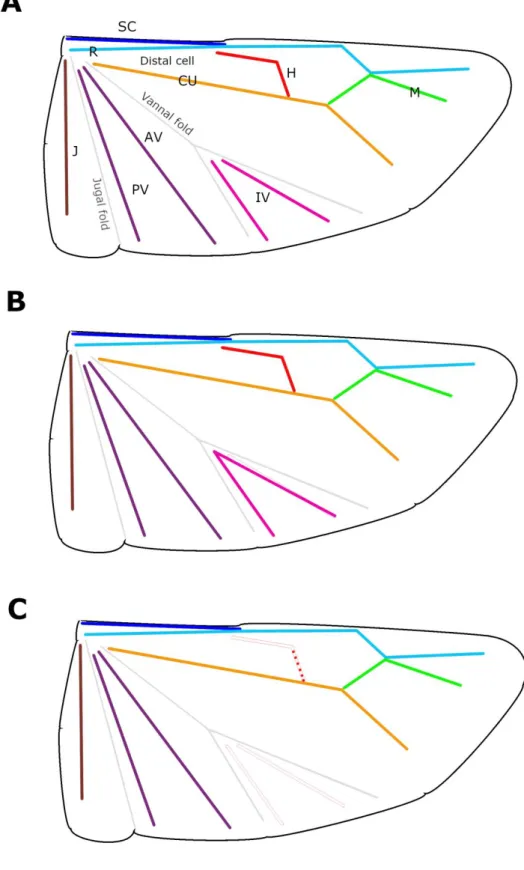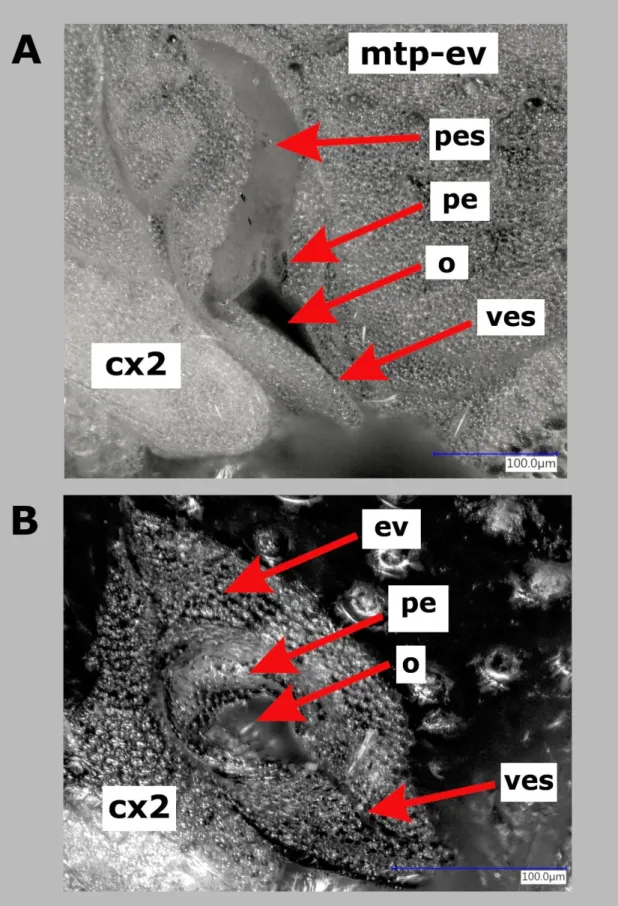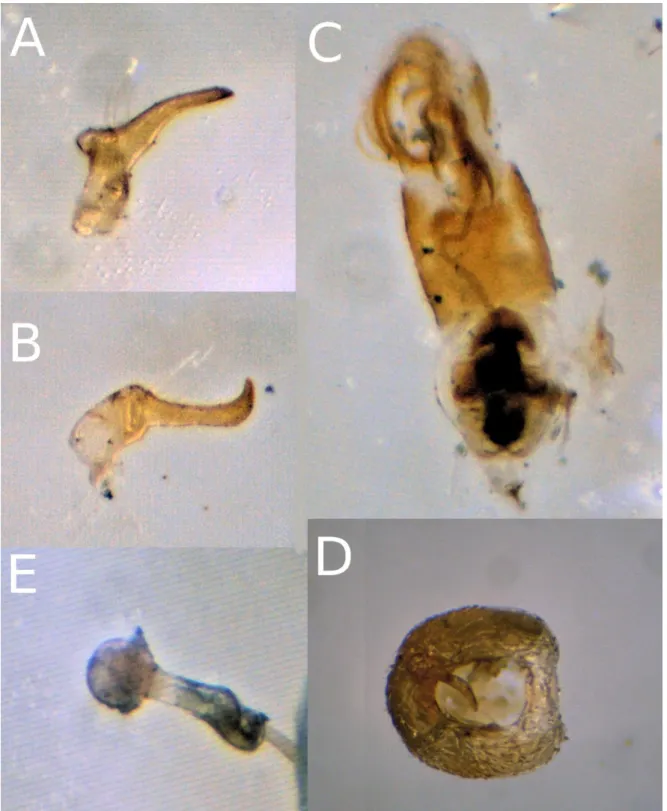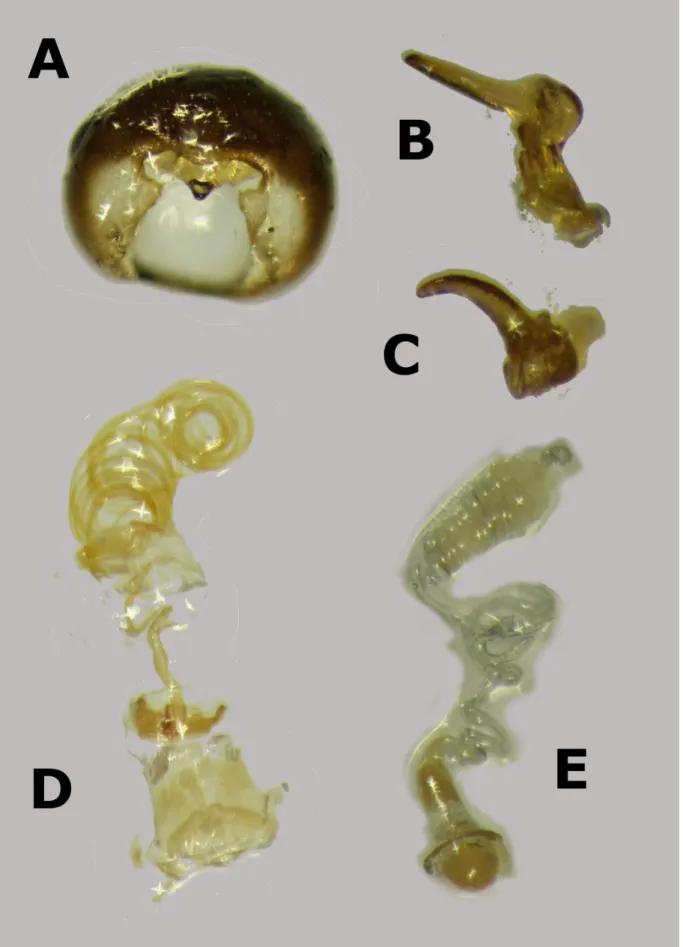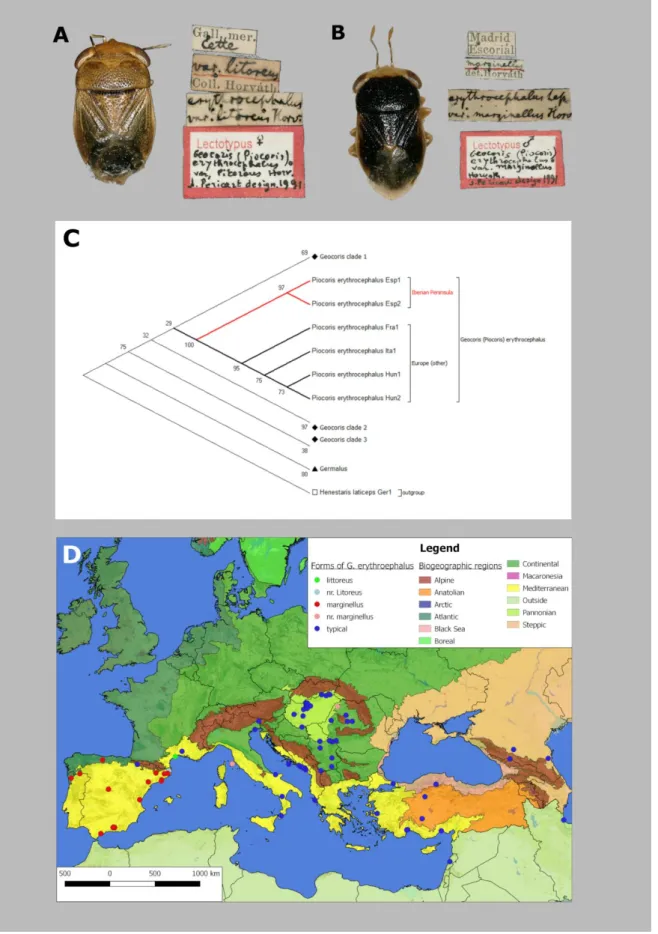1
2 PANNON EGYETEM
GEORGIKON KAR KESZTHELY
Festetics Doktori Iskola Iskolavezető: Dr. Anda Angéla, DSc.
Állattudományi Tanszék
DOKTORI (PH.D.)ÉRTEKEZÉS
INVESTIGATIONS ON THE TAXONOMY AND SYSTEMATICS OF BIG-EYED BUGS (HETEROPTERA: LYGAEOIDEA:GEOCORIDAE)
Témavezető: Dr. habil. Kondorosy Előd CSc, egyetemi tanár
Készítette: Kóbor Péter
Keszthely, 2020 DOI:10.18136/PE.2020.749
3
I
NVESTIGATIONS ON THE TAXONOMY AND SYSTEMATICS OF BIG-
EYED BUGS(H
ETEROPTERA: L
YGAEOIDEA: G
EOCORIDAE)
Értekezés doktori (PhD) fokozat elnyerése érdekében Írta: Kóbor Péter
Készült a Pannon Egyetem Festetics Doktori Iskola keretében Témavezető: Dr. Kondorosy Előd
Elfogadásra javaslom (igen / nem) ……….(aláírás) A jelölt a doktori szigorlaton ...%-ot ért el,
Az értekezést bírálóként elfogadásra javaslom:
Bíráló neve: …... …... igen /nem
……….
(aláírás)
Bíráló neve: …... …...) igen /nem
……….
(aláírás)
***Bíráló neve: …... …...) igen /nem
……….
(aláírás)
A jelölt az értekezés nyilvános vitáján …...%-ot ért el.
A doktori (PhD) oklevél minősítése…...
………
Az EDHT elnöke
4
T
ABLE OF CONTENT1. Abstracts ... 6
1.1. Abstract ... 6
1.2. Kivonat ... 6
1.3. Auszug ... 6
2. Introduction and review of literature ... 8
2.1. Introduction ... 8
2.2. A brief overview of the natural history of Lygaeoidea ... 10
2.3. An overview on big-eyed bugs (Heteroptera: Lygaeoidea: Geocoridae) ... 11
2.3.1. Morphology ... 11
2.3.2. Classification and diversity ... 12
2.3.3. Distribution ... 13
2.3.4. Ecology ... 13
2.4. An overview of subfamily Geocorinae Baerensprung, 1860 ... 16
2.4.1. Morphology ... 16
2.4.2. Classification and diversity ... 16
2.4.3 Distribution ... 19
2.4.4. Ecology ... 19
3. Materials and methods ... 20
3.1. Material studied ... 20
3.2. Morphological study ... 21
3.3. Molecular sequence data analysis ... 23
4. Results and Discussion ... 25
4.1. A review of morphological characteristics of Geocorinae ... 25
4.2. Contributions to the classification of Geocorinae ... 35
4.2.1. The applicability of the subspecies concept ... 35
4.2.2. Species groups within Geocoris based on molecular evidence (preliminary results) ... 39
4.2.3. Revisiting the tribal classification of Geocorinae ... 43
5. Summary ... 75
5
6. References ... 77
7. Theses ... 87
7.1. Theses ... 87
7.2. Tézisek... 88
Appendices ... 89
Appendix 1. – Defininition of characters and states used in cladistic analysis ... 89
Appendix 2. – Character matrix of cladistic analysis ... 91
6
1. Abstracts
1.1. Abstract
The aim of the recent study was the investigation of the systematic problems of the subfamily Geocorinae (Hemiptera: Heteroptera: Lygaeoidea: Geocoridae). This peculiar taxon needs thorough revisions at both species and generic levels as it was suggested by earlier studies. In course of the present work a combination of morphological knowledge and supplementary molecular sequence data was attempted in order to resolve systematic problems, e.g. the applicability of tribe and subspecies as taxonomic ranks in this family. The study resulted the partial revision of the second largest genus of the subfamily, Germalus Stål, 1862 including the description of five new species; the description of two new genus: one distributed in the Indomalayan Region and one from New Caledonia; and the evaluation of the applicability of the subspecies concept in the subfamily. Furthermore, preliminary evidences were acquired on the presence of coherent species-groups in Geocoris and the adequacy of tribal
classification of Geocorinae. Along with this preliminary reviews and revisions of discussed taxa and are provided.
1.2. Kivonat
Jelen dolgozat célja a Geocorinae alcsalád rendszertani problémáinak vizsgálata volt. Ez a különleges taxon mind faji, mind pedig genusz szinten átfogó revízióra szorul, ahogy azt korábbi tanulmányok is megállapították. A munka során a morfológiai ismeretek és
molekuláris szekvenciaadat-elemzés ötvözésével kísérlet történt olyan rendszertani problémák megoldására, mint a tribusz és alfaj rendszertani kategóriák alkalmazhatósága a családban. A vizsgálatok eredményei alapján megtörtént az alcsalád második legnagyobb genuszának (Germalus Stål, 1862) részleges revíziója, beleértve öt tudomány számára eddig ismeretlen faj leírását; leírásra került két új genusz: egy az Indomaláj térségből és egy Új-Kaledóniából; az alfaji kategória ezen alcsaládban történő alkalmazhatóságának újraértékelése. Továbbá előzetes bizonyítékok merültek fel a Geocoris genuszban feltételezett, koherens
fajcsoportokat és az alcsalád tribusz-beosztása helyességét illetően. Ezekkel együtt megtörtént a tárgyalt taxonok előzetes áttekintése és revíziója.
1.3. Auszug
Das Ziel von dieser Forschung war die Prüfung der taxonomischen Probleme von Unterfamilie Geocorinae. Eine umfassende Revision von diesem einzigartigen Taxon ist
7 notwendig auf beide Art- und Genusebene als es war schon von früheren Forschern empfehlt.
Während der Arbeit morphologische Kenntnis und molekulare Sequenzdaten waren
kombiniert zu lösen solchen Problemen wie die Anwendung von taxonomischen Kategorien in der Familie wie Tribus oder Unterart. Auf dem Grunde der Ergebnisse erfolgt eine partielle Revision der zweitgrößten Gattung, Germalus; auch Beschreibung von zwei neuen Gattungen aus der Indomalayen Region; Aufwertung von der Anwendung von Unterart als Kategorie in dieser Unterfamilie. Weiterhin, vorläufige Daten waren erworben am kohärent Art-Gruppen von Geocoris und Tribus-Zuordnung in der Unterfamilie. Zusammen mit diesen ist eine vorläufige Umschau und Revision von aufgehandelten Taxa auch gemacht.
8
2. Introduction and review of literature
2.1. Introduction
Big-eyed bugs (Geocoridae: Geocorinae) are peculiar representatives of the superfamily Lygaeoidea (sensu HENRY 1997) in terms of both appearance and feeding habits. These insects are readily recognised by their big, kidney shaped eyes, mostly ovoid habitus, and curved sutures between abdominal tergites. The family consists of nearly 30 genera comprising a sum of circa 290 known species divided into 5 subfamilies of which the nominotypical subfamily, Geocorinae is the most species rich and most widely distributed (HENRY 2009, RENGIFO- CORREA ET AL.2013,BRAILOVSKY 2016,KÓBOR 2019). Representatives of the subfamily are distributed in almost all biomes with warm and temperate climate or even in extreme biotopes like high mountains or deserts. Unlikely to other lygaeoid bugs which are seed- or sap-feeding, geocorids mostly known to be predaceous (SLATER 1977,SWEET 2000,CASSIS &GROSS 2002).
The food range of the species with well-studied autecology includes aphids and thrips, making them useful organisms in terms of biological pest management (KUMAR &ANANTHAKRISHNAN
1985,BUGG ET AL.1991,BRAMAN ET AL.2003). However, extensive applied ecological studies require a firm systematical basis which allows reliable identification.
The characteristic appearance of Geocorinae led to serious confusions and errors in terms of the taxonomy and systematics of the taxon. Early descriptions and diagnoses were based on superficial study of easy-to-observe characters, mostly colouration. The erroneous conclusions were later broadly accepted and resulted a nominotypical taxon which is to be considered as
“an ill-defined group of species belonging to perhaps several distinct genera” (MALIPATIL 1994) along with a relatively high ratio of mono- and oligotypic genera (e.g. MALIPATIL &BLACKET
2013,KÓBOR 2019a, b). Most of the studies on the representatives of the subfamily in the last decades restricted to description of new species, proposal of synonymies or studies on faunas of particular regions. The regions considered to be thoroughly studied at infrageneric level are the western part of the Palaearctic biogeographic realm (PÉRICART 1999), China (ZHENG &ZOU
1981,GAO 2010), Australia (MALIPATIL 1994,CASSIS &GROSS 2002,MALIPATIL &BLACKETT
2013), the eastern part of the United States (READIO &SWEET 1982) and Mexico (BRAILOVSKY
2016). However, several biodiversity hotspots like Madagascar or New Caledonia have remained virtually unstudied since the 1920’s until present day.
9 In course of the present study, based on the available literature on the biosystematics of Geocorinae and examination of material of various collections and recent field collectings, the following topics were investigated:
1) an evaluation and investigation of diagnostic and systematic characters at various levels within the subfamily;
2) a revision of the applicability of tribe, subspecies categories in the subfamily;
3) an evaluation of suspected species-groups along with a revision of the integrity of Geocoris Fallén, 1814;
4) a taxonomic revision of taxa included in Geocorinae.
The study was carried out with the application of an integrated approach, combining the data retrieved from a morphological study of exoskeletal and genital structures and an analysis of molecular sequence data using cladistic methods.
10 2.2. A brief overview of the natural history of Lygaeoidea
Lygaeoidea is the second largest superfamily in the infraorder Pentatomomorpha and is to be considered one of the most diverse groups of Heteroptera with more than 4515 species of 770 valid genera divided into 16 families, distributed worldwide (HENRY 2009, author’s unpublished data). The status of the superfamily and the included taxa were a subject of debate for decades (e.g. ŠTYS 1967, HENRY &FROESCHNER 1988 or SCHAEFER 1993). Based on the results of an extensive morphological phylogenetic study on the infraorder Pentatomomorpha HENRY (1997) fixed the status of the superfamily Lygaeoidea and revised its family level classification. The results of his study and the resulting classification of Lygaeoidea was accepted by most of the recent authors. Most recent investigation based on molecular sequence data (LI ET AL. 2005) suggest that Lygaeoidea might be paraphyletic, however, this hypothesis needs further support to invalidate the apparently strong morphological basis of the currently accepted classification. A recent and up to date catalogue on the superfamily was published online by HENRY &DELLAPÉ (2020) based on the works of SLATER (1964a, b) and SLATER &
O’DONNELL (1995), incorporating all subsequent changes published up to the present day.
In spite of their diversity, representatives of Lygaeoidea can be generally easily delimited from other heteropteran insects by the reduced, simple venation of the hemelytral membrane, mostly lacking closed cells, and the incrassate fore femora (this character is missing in some of the distal taxa) as concluded by HENRY (1997). This study mainly relied on literature data on the morphological characteristics of Lygaeoidea, thus the superfamily’s morphology can be considered well-known. Even earlier, comprehensive works provided thorough general descriptions, e.g. FLOR (1860), HORVÁTH (1875). Notable examples on in-depth analysis of separate character complexes are also to be found in the literature, e.g. wing structure (TILLYARD 1926, LAMEERE 1940, SLATER & HURLBUTT 1957), abdominal trichobothria (TULLGREN 1918, BUTLER 1923, GAO ET AL. 2017), or genitalia (VERHOEFF 1893, SINGH- PRUTHI 1925, CHINA 1933, ASHLOCK 1957, SCUDDER 1959).
SLATER (1977) recognised 7 major types of wing modification ranging from the complete absence of fore and hind wings (aptery) to entirely developed wings (macroptery).
Three major habitats typically colonized by lygaeoids were recognized by Slater (1975, 1977) and SLATER &BARANOWSKI (1990). All life stages of geophilic species live on the ground in litter and mostly feed on seeds (except Geocorinae); members of this group are likely to develop flightlessness and types of wing modification. The term laminaphilic is used to describe
11 lygaeoids (e.g. Blissidae) which live between the stem and leaf sheaths of grasses. These insects also show various forms of wing modifications but staphylinoidy and coleoptery are missing in the group. Arboreal lygaeoids spend most of their life cycle above the ground on dicotyledonous vegetation. Members of this group is always fully winged; and most of the lygaeoids belong here.
Most of the lygaeoid bugs are known as seed-feeders, but there are some sap-feeding taxa as well. The most unusual feeding habits in the superfamily are predation (Geocoridae) (e.g.
TAMAKI &WEEKS 1972) and hematophagy (Cleradini) (TORRES ET AL. 2000).
Comprehensive reviews on ecology, life history and human importance of the representatives of the superfamily were published by KIRKALDY (1907), BARBER (1923), SCHUH &SLATER
(1995) and SWEET (2000a), citing all important works on the topics. More recently an extensive overview on the evolutionary ecology of family Lygaeidae was published by BURDFIELD-STEEL
&SHUKER (2014).
2.3. An overview on big-eyed bugs (Heteroptera: Lygaeoidea: Geocoridae) 2.3.1. Morphology
The taxa included in the family Geocoridae are unusual representatives of Lygaeoidea in terms of morphology. These bugs are readily recognised by combination of following characters:
body mostly oval, elongate; head broad with eyes kidney-shaped, stylate; posterior edge of eyes often exceeding or encompassing the anterior margins of pronotum; median third of sutures between abdominal tergites 4/5 and 5/6 curved posteriad medially; abdominal spiracles II-IV dorsal (HENRY 1997).
Despite the common attributes shared by the representatives of the subfamily a high degree of morphological heterogeneity and specialization can be observed within the contained taxa. Ant- mimetics is to be considered as relatively common phenomenon as it is present by geocorid bugs of various regions and biomes of the world e.g. Bledionotus systellonotoides Reuter, 1878 (Middle-East, semideserts), Stenogeocoris horvathi Montandon, 1913 (Argentina, grasslands), Cattarus Stål, 1858 (Central- and South-America, rainforests). Another characteristic group is genus Epipolops Herrich-Schaffer, 1850 which can be characterized with strongly stylate eyes and projections of pronotum. The genus Geocoris itself shows considerable variety too.
Examples on diversity of Geocoridae are shown in Figure 1.
12 2.3.2. Classification and diversity
The big-eyed bugs (Geocoridae) is a moderately species rich but morphologically rather heterogeneous family of Lygaeoidea (Hemiptera: Heteroptera) distributed in all biogeographic realms of warm and temperate climate. For a long time, the group was recognized as a subfamily within a broadly defined Lygaeidae but it was raised to family rank by HENRY (1997). It currently consists of 5 subfamilies and comprises about 28 valid genera with 288 known species (HENRY 2009, MALIPATIL 2012, RENGIFO-CORREA ET AL. 2013).
The nominotypical subfamily, Geocorinae is by far the largest of the five subfamilies, including more than 220 described species of 16 genera (BRAILOVSKY 2016) with almost worldwide distribution. Australocorinae is a recently established subfamily endemic to Australia (MALIPATIL 2012) consisting of a single genus including 3 species. Representatives of the subfamily Henestarinae are known from the Palaearctic Region except for the problematic genus Coriantipus Bergroth, 1912 (HENRY ET AL. 2015). The subfamily Bledionotinae consists of a monotypic genus, its single species is myrmecomorphic, distributed in the Middle East from Syria to Tajikistan (SLATER 1964). The morphologically heterogeneous Pamphantinae was reduced to be tribe of Bledionotinae (SCUDDER 1963), but later was resurrected from the synonymy (HENRY 1997). SLATER (1999) classified the included taxa into three tribes:
Cattarini, Epipolopini and Pamphantini. Representatives of Pamphantinae was thought to be distributed in the Neotropics apart from Austropamphantus woodwardi Slater, 1981, an
Subfamily Author, year Number of included genera/
species
Distribution
Australocorinae Malipatil, 2012 1/ 3 Australian
Bledionotinae Reuter, 1878 1/ 1 Iranian (desert)
Henestarinae Douglas & Scott, 1865
3/ 14 Palaearctic, Neotropic
Geocorinae Baerensprung, 1860 17/ ~220 sub-cosmopolitan
Pamphantinae Barber & Bruner, 1933
12/ 49 Neotropic, Australian, Indomalayan
Table 1.: Subfamilies of Geocoridae
13 Australian species, but recently a new tribe, Indopamphantini, was described to the subfamily including two monotypic genera from the Indomalayan biogeographic realm (MALIPATIL 2017, MALIPATIL & SCUDDER 2018). Epipolops Herrich-Schaffer, 1850, the largest genus of the subfamily was subject of the first phylogenetic study published on the family Geocoridae (RENGIFO-CORREA ET AL. 2013). Currently this subfamily comprises altogether 48 species in 12 genera and four tribes (DELLAPÉ &HENRY 2019).
2.3.3. Distribution
Representatives of the family Geocoridae are distributed in almost every biomes of the World with warm and moderate climate (BRAILOVSKY 2016). The species-richness of the family reaches its maximum in the tropics e.g. the Australasian, the Indomalayan and the Neotropical regions.
The Australasian region is one of the most extensively studied and is outstandingly rich in endemic monotypic genera (MALIPATIL 1994, CASSIS & GROSS 2002, MALIPATIL 2012, MALIPATIL &BLACKETT 2013).
In the Neotropics three of the five subfamilies of Geocoridae are present: Geocorinae, Henestarinae and Pamphantinae. However, the status of Coriantipus inopinatus is questionable.
The region is well-studied, multiple revisionary works were published recently e.g.
BARANOWSKI &SLATER (2005),DELLAPÉ (2014),DELLAPÉ ET AL.(2015),HENRY ET AL.(2015), BRAILOVSKY (2016).
The Palaearctic realm is inhabited by representatives of Geocorinae, Henestarinae and Bledionotinae. The Western parts of the region was reviewed thoroughly in the large-scale monographic work of PÉRICART (1999) on Euro-Mediterranean Lygaeoidea. KERZHNER (1979) revised the Mongolian fauna of genus Geocoris which is a fundamental work in terms of the North-Eastern part of the Palaearctic region. The fauna of China is also well-reviewed by the studies of ZHENG &ZOU (1981) andGAO (2010).
In terms of the Nearctic realm the study of READIO &SWEET (1982) is to be mentioned as fundamental publication with valuable taxonomic suggestions on genus Geocoris generally.
2.3.4. Ecology
Representatives of the family are mostly geophilic, but some of them are thought to be arboreal according to SLATER (1977) and SLATER &BARANOWSKI (1990). Geophilous species live on
14 the ground, in the litter layer. These species are often brachypterous and flightless while arboreal species live on plants, having fully developed wings and are ready to fly.
Unlikely to most lygaeoid bugs which are obligatory seed- or sap-feeding, Geocoridae are mostly highlighted for their predatory feeding. However, it must be noted that geocorids are rather omnivorous than obligatory predators. In the absence of prey, they can survive on plant parts with preference on seeds and pollen. Prey spectrum of the taxa with well-studied ecology mostly consists of aphids, moth larvae and thrips thus some of the geocorid bugs are to be considered as potentially beneficial organisms in terms of biocontrol and integrated pest management (KUMAR &ANANTHAKRISHNAN 1985,SWEET 2000b).
15
Figure 1. Examples on diversity of Geocoridae – A. Engistus exanguis confurcatus Horváth, 1911; lectotype, HNHM. B.
Piocoris erythrocephalus erythrocephalus (Lepeletier and Serville, 1825); HNHM. C. Nannogermalus marmoratus (Kóbor, unpublished); paratype, NHMW. D. Geocoris grylloides (Linnaeus, 1761); HNHM. E. Germalus greeni Distant, 1910;
holotype, BMNH. F. Cattarus formicarius (Distant, 1893); holotype, BMNH. G. Epipolops oculuscancri (Distant, 1893);
lectotype, BMNH. H. Geocoroides polytretus Distant, 1918, holotype, BMNH. I. Stenogeocoris horvathi Montandon, 1913;
holotype, HNHM.
16 2.4. An overview of subfamily Geocorinae Baerensprung, 1860
2.4.1. Morphology
Representatives of Geocorinae can be generally characterized by the combination of the following characters: head pentagonal, eyes moderately or slightly stylate; pronotum mostly trapezoidal, sometimes widened; scutellum triangular with variably developed medial trifurcate carina; hemelytron mostly macropterous or submacropterous, wing polymorphism occur group- specifically; sutures of abdominal tergites IV–VI curved; abdominal spiracles II–IV dorsal and V–VII ventral.
Though the subfamily is a peculiar taxon of Lygaeoidea the delimitation of groups within the subfamily is unclear and the diagnostic characters need to be revised. There are multiple characters suggested which were later overlooked or omitted:
Furrows of vertex were proposed as diagnostic characters by READIO &SWEET (1982). The taxonomic significance of proportion of labiomeres was argued by LINNAVUORI (1972) and later by READIO &SWEET (1982). Morphology of hind wing venation (Fig. 6A) was extensively studied in Lygaeoidea by SLATER &HURLBUTT (1957) and gave examples on Geocorinae, but the character was not studied extensively within the representatives of the subfamily.
BERGROTH (1916) suggested on the implication of metathoracic scent efferent apparatus (MTSEA) as diagnostic character, but the character remained virtually unstudied. However, its importance was proved recently in other heteropteran families, e.g. KMENT &VILIMOVÁ (2010).
In situ position of male paramere as diagnostic character was proposed by the key of BRAILOVSKY (2016).
2.4.2. Classification and diversity
Geocorinae, the nominotypical subfamily of Geocoridae, is the largest among the five subfamilies of the family comprising about 220 known species of 16 valid genera (BRAILOVSKY
2016). The taxon was first proposed in BAERENSPRUNG’s (1860) systematic work on European Heteroptera. The first researcher who extensively studied the taxon was the Swedish hemipterist STÅL (1862a, b, 1866, 1872, 1874) publishing four comprehensive works on the representatives of the subfamily, providing description and keys along. During the second half of the 19th century European representatives of the taxon were extensively studied e.g. by HORVÁTH
(1875), PUTON (1879), ACLOQUE (1897). WALKER (1872) catalogued the specimens deposited in the collection of Natural History Museum, London. DISTANT (1893, 1904) provided a strong basis for the research of the Central America and the Indian subcontinent. One of the most
17 prolific researchers of the subfamily in the first decades of the 20th century was MONTANDON
(1907, 1908, 1913a, b, c) – a French hemipterist living in Romania – who described and revised multiple species and genera worldwide and built a notable collection which is now deposited in the Hungarian Natural History Museum (Budapest, Hungary), Kimball Natural History Museum (San Francisco, USA) and Grigore Antipa Museum (Bucharest, Romania).
MONTANDON (1913a) proposed to classify the geocorine genera into two tribes, Geocorini and Germalini. He concluded that Germalini can be defined by the complete ocular sulcus, subequilateral scutellum, and parallel-sided clavus with completely developed claval commissure. Contrastingly, taxa contained in Geocorini show different levels on reduction of ocular sulcus, have elongate scutellum and margins of clavus converging apically, with claval commissure reduced. After purchasing Montandon’s collection PARSHLEY (1921) developed this concept based on the work of MONTANDON (1913a) and the collection material, however, the entire hypothesis was never published in detail. This idea never spread widely: the most recent mention of Germalini is found in BARBER’S (1958) study on Micronesian fauna, and this name was omitted by all subsequent authors. The Lygaeidae world catalogue (SLATER 1964) uses tribe Geocorini to separate Psammini which was later upgraded to subfamily (SLATER &
SWEET 1965) and recently placed in Piesmatidae (HENRY 1997) from the rest of the subfamily.
The tribal classification is presently unused. However, overlooked evidence strongly supports it. SLATER &HURLBUTT (1957) in course of the study of hind wing venation in Lygaeidae concluded that based on the reduction of hamus and presence of intervannals two lineages can be recognised in Geocoridae: the geocorine line has reduced hamus and missing intervannals, and a henestarine line (including Germalus) with hamus complete and present intervannals, fused basally. These conclusions were not implied in later studies and the concept of tribal classification of Geocorinae remained virtually forgotten. However, there are multiple examples on such division of subfamilies in Lygaeoidea e.g. Rhyparochomidae (SWEET 1975) or the geocorid Pamphantinae (HENRY 2013).
The largest geocorine genus is the nominotypical Geocoris Fallén, 1814, comprising about the two-third of the known species of the subfamily. The genus is currently divided into three subgenera: Geocoris Fallén, 1814, Piocoris Stål, 1872 and Eilatus Linnavuori, 1972. The status of Piocoris was a subject of debate until LINNAVUORI (1972) fixed it as subgenus of Geocoris, concluding that the diagnostic characters of the taxon do not merit the usual requirements of generic rank. Piocoris was separated from Geocoris sensu stricto based on proportion of II and III labial segments (in Piocoris segment II is longer than segment III) and the oblique apex of
18 scutellum. READIO & SWEET (1982) doubted Linnavuori’s action exemplifying the case of Isthmocoris McAtee, 1914 which was separated with the same certain diagnostic character (proportion of labial segments) from Geocoris as Piocoris. Eilatus was diagnosed with the obliquely truncate apex of antennal segment I, and segment II being armed with small spines.
Besides the subgenera, coherent species groups within Geocoris were recognized by different authors e.g. READIO AND SWEET (1982) or PÉRICART (1999). MALIPATIL (1994) in course of revising the species of the genus distributed in Australia concluded that Geocoris is “an ill- defined group of species belonging to several taxa possibly rank equal to existing genera”, referring to READIO &SWEET (1982).
Germalus Stål, 1862 is the second largest genus of the subfamily with 35 species. The taxon is distributed from the Afrotropical to the Oceanian biogeographic realms. The study of the genus virtually stopped after the 1950’s (BARBER 1958) but gained a new momentum in 2010’s with the works of MALIPATIL &BLACKETT (2013) and KÓBOR &KONDOROSY (2016, 2017). The status of several species is still uncertain e. g. members of New Caledonian fauna, and there are regions like New Guinea which are virtually unstudied since the first decades of the 20th century. MONTANDON (1913a) established a new genus, Neogermalus Montandon, 1913 based on the head shape. Type species of the genus was Ophthalmicus membranaeus Montrouzier, 1861 by monotypy. BERGROTH (1916) claimed that the specimen Montandon “redescribed”
was not conspecific with Montrouzier’s taxon and found that the diagnostic characters were unsuitable for generic level definition, thus he synonymized Neogermalus with Germalus. In the same study, Ophthalmocoris (?) dissidens Montandon, 1907 was moved to the newly established genus Nesogermalus Bergroth, 1916 and was designated as its type species; the new genus was based on the shape of metathoracic scent efferent apparatus (MTSEA) and antenniferous tubercle.
Ninyas Distant, 1882 is morphologically highly similar to representatives of Germalus, yet it is distributed in the Caribbean region. The genus can be considered as well-known due to the revisionary works of BARANOWSKI &SLATER (2005) and BRAILOVSKY (2013, 2016). A few of the smaller genera of the subfamily were recently revised or described, e.g. Isthmocoris McAtee, 1914 (READIO &SWEET 1982), Stylogeocoris Montandon, 1913 (MALIPATIL 1994) or Ausogeocoris Malipatil, 2013, but most of the other taxa need revision.
19 2.4.3 Distribution
Representatives of the subfamily are to be found in almost all biomes of warm and temperate climate. Some species inhabits extreme places like high mountains or deserts. However, tropical regions are richest in species: the number of taxa descend as we move further from Equator, though there are few species – especially in the Palaearctic Region – which nearly reach the Arctic circle (author’s unpublished data). One of the most diverse and species rich biogeographical realms is the Australasian Region, with several endemic, mono- or oligotypic taxa as concluded by MALIPATIL (1994), MALIPATIL &BLACKETT (2013) and KÓBOR (2019a, b).
2.4.4. Ecology
In terms of autecology and lifecycle, members of the genus Geocoris along with other Palaearctic taxa included in PÉRICART’S (1999) comprehensive work on Euro-Mediterranean representatives of the subfamily are to be considered as well-known.
The most extensively studied species in this regard is the Nearctic Geocoris punctipes (Say, 1831) (e.g. COHEN 1985,BUGG ET AL.1991,TORRES &RUBERSON 2006). Furthermore, research on the lifecycle, feeding habits and rearing of the Nearctic Geocoris bullatus (Say, 1831), Geocoris pallens Stål, 1854 (TAMAKI &WEEKS 1972) and Geocoris uliginosus (Say, 1831) (BRAMAN ET AL. 2003), the Oriental Geocoris ochropterus (Fieber, 1844) (KUMAR &
ANANTHAKRISHNAN 1985), Geocoris varius (Uhler, 1860) or Geocoris proteus Distant, 1883 (SAITO ET AL. 2005) and the Australian Geocoris lubra Kirkaldy, 1907 (MANSFIELD ET AL. 2007) were conducted. Predatory behaviour in genus Germalus was recorded by USINGER
(1936).
20
3. Materials and methods
3.1. Material studied
Specimens studied and processed in the course of this study are mostly originated from the collections of following museums:
BMNH – The Natural History Museum, London, United Kingdom BPBM – Bernice P. Bishop Museum, Honolulu, Hawaii
HNHM – Hungarian Natural History Museum, Budapest, Hungary KNHM – Kimball Natural History Museum, San Francisco, USA MZMB – Moravian Museum, Brno, Czech Republic
MNHN – Museum National d’Historie Naturelle, Paris, France NHMB – Naturhistorisches Museum, Basel, Switzerland NHMW – Naturhistorisches Museum, Vienna, Austria
NHRS – Swedish Museum of Natural History, Stockholm, Sweden PCTR – the Personal collection of Thibault Ramage, France
PCZJ – the Personal collection of Zdenek Jindra, Prague, Czech Republic RBINS – Royal Belgian Institute of Natural Sciences, Brussels, Belgium RMCA – Royal Museum of Central Africa, Tervueren, Belgium
SEMC – University of Kansas Biodiversity Institute (Snow Entomological Collections), Lawrence, USA
USIL – University of Silezia, Katowice, Poland ZMHB – Natural History Museum, Berlin, Germany
Specimens subject of molecular studies were collected in 2014-2018 by Előd Kondorosy (University of Pannonia, Keszthely, Hungary), Barna Páll-Gergely (Institute of Plant Protection, Centre for Agricultural Research, Hungarian Academy of Sciences, Budapest, Hungary), Dávid Rédei (Nankai University, Tianjin, China), Marcos Roca-Cusachs (Department of Evolutionary Biology, Ecology and Environmental Sciences, Faculty of Biology, University of Barcelona, Spain), specimens are summarized in the following table:
21
Genus species Localities Notes
Geocoris Fallén, 1814
collaris Puton 1878 Iberian Peninsula, Canary Islands (Spain)
erythrocephalus Lepeletier & Serville, 1825
France, Hungary, Italy, Iberian Peninsula (Spain)
2 specimens collected in the same locality (Hungary)
lineola (Rambur, 1839)
Iberian Peninsula (Spain) 2 specimens collected in the same locality
pubescens (Jakovlev, 1871)
Iberian Peninsula (Spain)
varius (Uhler, 1860) Yunnan (China) ochropterus (Fieber,
1844)
Yunnan (China)
Germalus Stål, 1862
greeni Distant, 1910 Yunnan (China) sobrinus (Stål, 1859) Yunnan (China) Table 2. List of specimens subject of DNA extraction
Label data processing
Label data cited verbatim; lines on labels separated with “/”, content of labels separated with
“//”. Specimens marked with “†” were subject of DNA extraction. Handwritings on labels of specimens originated from museum collections were identified with the help of HORN’s (1926) work on entomological collections.
Life Science Identifier (LSID) of species – if applicable – was acquired from Lygaeoidea SpeciesFile (LSF) (DELLAPÉ &HENRY 2019). Literature data not listed in LSF-database is cited respectively.
Label data was recorded in comma delimited text (.csv) format using Microsoft Excel Standard 2010 software. GPS coordinates belonging to collection sites (if not available) were acquired from Google Maps in decimal format. Data deficient records (e.g. locality too generally defined) were excluded from database. File was processed with QGIS 2.18.7 software; maps were generated with the implying GlobCover v2.3 raster (ARINO ET AL. 2010) and WWF terrestrial ecosystems shape (OLSON ET AL. 2001) layers for projection.
3.2. Morphological study
Taxonomy. Examination of exoskeletal and genital structures was performed using Leica Mz 9 5 stereoscopic and Keyence VHX 5000 digital microscopes. Photo documentation was done by
22 the author using Keyence VHX 5000 digital microscope. Photos of Apennocoris pilosulus Montandon, 1907 syntype was taken by Scott Bundy (New Mexico State University).
Genitalia were examined after removal of the whole abdomen and soaking it overnight in lactic acid solution at room temperature. When soaking in lactic acid, structures remain more flexible than by KOH maceration according to the author’s experience. This method also prevents
“overmacerating” of structures (BLAHNIK ET AL. 2007), thus additional dye staining is not necessary before further dissection, observation or photographic documentation.
Measurements were made using an ocular micrometer and were performed on scaled photos with the use of the ImageJ software. Values are given in millimetres; values for primary types (holotype or lectotype) are indicated by bold letters, range of paratypes and other materials are given in parentheses. Missing appendages or non-measurable characters are marked with “n/a”.
General morphological terminology used in this article was adapted from TSAI ET AL. (2011) and MALIPATIL &BLACKETT (2013). Terminology for external structures of the metathoracic scent efferent apparatus (MTSEA) was adapted from KMENT &VILÍMOVÁ (2010). Terminology for wing morphology was adapted from SLATER &HURLBUTT (1957) and SLATER (1975, 1977).
Morphology was reviewed and revised based on the works of MONTANDON (1913a), BERGROTH
(1916), ASHLOCK (1957), SLATER & HURLBUTT (1957), BARBER (1958), READIO & SWEET
(1982), MALIPATIL (1994), HENRY (1997), PÉRICART (1999), MALIPATIL &BLACKETT (2013) and BRAILOVSKY (2016).
Tribal and generic level keys were partly adapted from MALIPATIL (1994), PÉRICART (1999) and MALIPATIL &BLACKETT (2013).
Due to page constraints, short diagnoses are provided in the “Taxonomy” subchapter. Detailed descriptions, label data and measurements can be found in the cited articles of the author.
Cladistic analysis. Besides the type species of genera considered as valid (SLATER 1964,SLATER
&O’DONNELL 1995,HENRY &DELLAPÉ 2019), representatives of species groups suggested by READIO &SWEET (1982) and PÉRICART (1999) were included in the analysis.
Characters analysed were derived by the critical review of literature data acquired in course of the revision of morphology as specified above. Definitions of characters are found in Appendix 1. A character matrix of 31 characters was generated using the software Mesquite 3.6 (MADISSON & MADISSON 2018); 26 characters were coded as binary and 5 as multistate
23 (Appendix 2). Character polarization followed the outgroup method of NIXON &CARPENTER
(1993).
Parsimony analysis was performed with TNT 1.1 software (GOLOBOFF ET AL. 2008) using Traditional Search method with default settings under equal weights. All characters were treated non-additive. Support values were estimated with Majority- Rule Consensus of resulted trees.
3.3. Molecular sequence data analysis
For the purpose of DNA extraction, entire abdomens of previously identified individuals were dissected. Genital capsules were removed and preserved for further morphological study;
voucher specimens were deposited in the Hemiptera Collection of HNHM. DNA extraction was performed with use of Sigma-Aldrich “REDExtract-N-AmpTM Seed PCR Kit” according to manufacturer’s protocol. The amplification was done with the C1-J-1718 and C1-N-2191 primers (LOXDALE &LUSHAI 1998) in 100 μl total volume. This primer is fitted for the barcode region of COI but was designed for arthropods. The temperature profile of reaction was the following: initial denaturation for 4 minutes at 95 °C; 35 cycles of 30 seconds at 95 °C, 1 minute at 50 °C, 2 minutes at 72 °C; final extension for 10 minutes at 72 °C. PCR-product was purified with Roche “High Pure PCR Product Purification Kit” according to manufacturer’s protocol.
Purified product was imaged on 1% agarose gel dyed with EtBr. Sequencing was done at BayGen Genomic Unit of Biological Research Centre, Hungarian Academy of Sciences (Szeged, Hungary).
Additional sequences were acquired from NCBI GenBank with the use of BLAST tool (see table for accession number).
Species Codes in trees NCBI Accession
Number
Geocoris (Geocoris) ater (Fabricius, 1787) GeoateGer1 KM022926 Geocoris (Geocoris) discopterus Stål, 1874 GeodicCnd1
Geocoris (Geocoris) dispar (Waga, 1839) GeodisGer1 KM022291 Geocoris (Piocoris) erythrocephalus (Lepeletier & Serville,
1825)
PioeryFra1
KJ541560
Geocoris (Geocoris) grylloides (Linnaeus, 1761) GeogryGer1 KM021943 GeogryGer2 KM021986
24 Geocoris (Geocoris) howardi Montandon, 1908 GeohowCnd1 HQ105696
GeochowCnd2 HQ105697 Geocoris (Geocoris) limbatus (Stål, 1874) GeolimCnd1 KR041225 Geocoris (Geocoris) pallens Stål, 1854 GeopalCnd1
Geocoris (Geocoris) uliginosus (Say, 1831) GeouliCnd1
Germalus sp. 1. GersppFrP1 AY252930
GersppFrP2 AY253137
Germalus sp. 2. GersppFrP3 KX053267
Table 3. List of additional sequences acquired from NCBI GenBank
Sequences were aligned using the ClustalW software. The final dataset comprised 29 sequences with length of 398bp, representing 15 species of 3 genera. Length of sequences were cropped to the shortest sequence. Maximum Likelihood analysis was performed with use of MEGA X (KUMAR ET AL. 2018) and RAxML 8.0.0. (STAMATAKIS 2014) software. TAMURA-NEI (1993) substitution model with a discrete Gamma distribution was chosen based on the Akaike information criterion (AIc) scores of MEGA X software’s model estimation tool. Bootstrap value (FELSENSTEIN 1985) was set to 1000 replicates in each case. KIMURA (1980) 2-parameters distance estimation was run pairwise using MEGA 7; results were processed and interpreted with the use of Microsoft Excel Professional Plus 2010 software.
25
4. Results and Discussion
4.1. A review of morphological characteristics of Geocorinae
Head (Fig. 2) – Generally pentagonal, eyes moderately or slightly stylate. Moderately stylate eyes which sometimes erect or prorect are characteristic mostly in Germalus and allies (Fig.
2A). In Geocoris and closely related genera eyes at most slightly stylate (Fig. 2B-C);
occasionally vertex broadened, head nearly lunate (e.g. Piocoris, Geocoris ochropterus and closer relatives) (Fig. 2C). Ocular sulcus complete (Germalus and allied genera) or reduced (Geocoris and relatives). Surface of vertex rugose or smooth, rarely punctate (Ausogeocoris, Unicageocoris); if rugose then frequently with fine decumbent pubescence. Vertex frequently with transversal furrows anterior to ocelli (Fig. 2B) or longitudinal median furrow on vertex of various length (Fig. 2C). Clypeus of characteristic shape in certain groups (Figs. 2A–C). Jugal sutures of clypeus usually present, occasionally reduced (Geocoris and some closely related genera). Antenniferous tubercle usually unarmed, occasionally armed with tooth-like process (New Caledonian taxa, e.g. Nesogermalus). Antennomeres usually simple, in Eilatus armed with spine-like bristles. Labial trough open or partly closed, U- or V-shaped (Germalus, Stylogeocoris and related genera) or closed or at most slightly open, Y-shaped (Geocoris and allies), with a suture of variable length probably representing remnant of margin of trough.
Labiomeres of variable length, length of labiomere I apparently not independent from development of labial trough; taxonomic significance of labiomere proportions is not fully explored but in certain cases it might be used for defining generic level taxa.
26
Figure 2. Characters of head and cephalic appendages in Geocorinae (I) – A. Head in dorsal view of Ausogeocoris westraliensis Malipatil, 2013; Head in dorsal view of Geocoris ater spp. Fabricius 1787; Head in dorsal view of Piocoris erythrocepahlus spp. (lettering: at – antenniferous tubercle, as1 – antennal segment 1, cl – clypeus, mp – mandibular plates, o – ocellus, oc – ocular sulcus)
27 Thorax and thoracic appendages (Figs. 1, 4–6) – Pronotum from semi-circular to rectangular but most commonly trapezoidal with slight impressions on lateral margins (Fig. 1). Surface variably punctate, sometimes with silvery pubescence, thoracic callosities, anterior and posterior margins and humeral angles with variously extensive impunctate areas. Integument glabrous or finely, inconspicuously pilose, occasionally with dense silvery pubescence (e.g.
Geocoris pubescens) or erect setae dorsally (Apennocoris). Pronotal callosities variously developed (Figs. 4A and B), a few species with median longitudinal carinae; both characters of diagnostic value at species level.
Scutellum triangular, either subequilateral (Germalus and allied genera) or elongate (Geocoris and closer relatives); apex mostly sharply pointed, sometimes rounded (Piocoris and some Indomalayan Geocoris species) (Figs. 4C–E); with a variously developed median trifurcate carina, characteristically reduced in Geocoris and allies (Figs. 4C–E); integument densely punctate except carina.
Fore wing: clavus usually clearly distinguishable, with subparallel margins and well developed, conspicuous claval commissure (Germalus and allies) or with margins gradually converging apically and claval commissure reduced (Geocoris and allies); in short-winged morphs sometimes indistinguishably fused with corium (see later by wing polymorphism). Punctation of corium highly variable, from punctures arranged along corial veins to evenly punctate (Figs.
5A–E); in New Caledonian geocorines and in Ninyas arranged in a characteristic S-shape (figure 5D).
Wing polymorphism mostly found in Geocoris and closely allied genera. In case of some Nearctic and Palaearctic Geocoris species, e.g. Geocoris ater Fabricius, 1787 or Geocoris bullatus (Say, 1831), macropterous and brachypterous individuals can be observed within the same population. Coleoptery can usually be found in species distributed in highland regions, e.g. Geocoris chinai Kiritshenko, 1931 (Tibet), Geocoroides polytretus Distant, 1918 (Nilgiri Mts., southern India) (Fig. 1H) or Pseudogeocoris fallaciosus Montandon, 1913 (Tanzania).
The most uncommon modification, staphylionidy, can be observed in Stenogeocoris horvathi Montandon, 1913 (Fig. 1I). In Germalus and allies, wings are always fully developed. In regard of metathoracic wing venation two separate lineages are recognisable: the “germaline-line”
where hamus and basally fused intervannals are present (Fig. 6B) and a “geocorine-line” where hamus underwent different levels of reduction and intervannals are missing (Fig. 6C).
28 Metathoracic scent efferent apparatus (MTSEA) either with oval or irregular-shaped ostiole, opening narrowing gradually into vestibular scar, with elongate peritreme, peritremal surface of various size and shape (can reach up to 2/3 of metapleurite), evaporative area covering most of the metapleurite, frequently extending to posterior half of mesopleurite (Fig. 6A) (“germaline-line”); or ostiole more or less round, closing sharply, resulting in a longer vestibular scar, peritreme bulging, peritremal surface missing, evaporative area restricted mostly to the immediate surrondings of the peritreme (“geocorine-line”). The punctation of evaporative area, length and shape of peritremal surface and exact shape of ostiole have diagnostic value at species level in the “germaline-line”, whilst the extent and shape of evaporative area, shape of peritreme and ostiole and the arrangement of vestibular scar can be considered as species-level discriminatory characters in the “geocorine-line”. Metapleurite undivided or divided into two lobes by a furrow above the metacoxa (in Germalus and allies).
Legs usually without peculiarities. Femora unarmed; tibiae with longer pubescence, in some genera (e.g. Umbrageocoris) with spine-like, erect setae which is possibly a sign of adaption to predatory behaviour and serves to catch and grab prey.
29
Figure 3. Thoracic dorsum of Geocorinae: Pronotum – Geocoris ater (A), Eilatus chloroticus (B); scutellum and hemelytron – Geocoris ater (C), Neogermalus membranaeus (D), Piocoris erythrocephalus (E); hemelytron – Geocoris grylloides (F).
30
Figure 4. Metathoracic wing in Geocorinae (diagrammatic): A. Lygaeoidea, generalized, B. Germalini, C. Geocorini.
(Lettering of veins: AV – Anterior vannal; CU – Cubitus; H – hamus; IV – intervannals; J – Jugal; M – Media; PV – Posterior vannal; R – Radius; SC – Subcosta)
31
Figure 5. Metathoracic scent efferent apparatus in Geocorinae: A. Germalus costalis Van Duzee, 1932 (Geocorinae:
Germalini), holotype, BPBM; B. Umbrageocoris maai maai Kóbor, 2019 (Geocorinae: Geocorini), holotype, BPBM.
(Lettering: cx2 – mesocoxa; ev – evaporative area; mtp-ev – metapleurite with evaporative area; o – ostiole; pe – preitreme;
pes – peritremal surface; ves – vestibular scar)
32 Abdomen – Sutures of abdominal tergites 4/5 and 5/6 curved posteriad medially as in other taxa of the family Geocoridae. Abdominal dorsum is smooth in most of the genera included, but rugose (Umbrageocoris) or punctate (Stylogeocoris) surfaces occur as well. Abdominal venter often with fine, decumbent pubescence; stronger, erect setae may occur near genital capsule, most frequently in Germalus, but occasionally in other taxa of the subfamily.
Female genitalia. Length of ovipositor shows considerable interspecific variations in some of the genera; in Germalus – similarly to Henestaris – reaches up to abdominal connexiva IV (Fig. 7C), whilst in Geocoris it is shorter, not exceeding segment VII (Fig. 7D). Spermatheca similar in most of the cases, only spermathecal duct bears considerable, generic level
differences, as it can be bent, looped or coiled (Figs. 7E–F.).
Male genitalia. Pygophore has two main characters which can be applied at generic level:
shape of posterior opening; shape of lateral processes. Shape of opening is more variable even on generic level, but shape of processes can be divided into a blunt “germaline type” and a sharply pointed “geocorine type”. Relative position of male parameres in pygophore was found to be overlapping in Geocoris and allies and crossing each other, forming an X shape in taxa related to Germalus.
33
Figure 6.Genital structures in Geocorinae I. – Germalus banari Kóbor & Kondorosy, 2016: A. male paramere in dorsolateral view, B. male paramere in anterolateral view, C. male aedeagus, D. male pygophore in posterior view, E.
female spermatheca.
34
Figure 7.Genital structures in Geocorinae II. – Geocoris margaretarum Kóbor, 2018: A. male pygophore in posterior view, B: male paramere in dorsolateral view, C. male paramere in posterolateral view, D. male aedeagus, E. female spermatheca.
35 4.2. Contributions to the classification of Geocorinae
4.2.1. The applicability of the subspecies concept
The concept of subspecies was a source of controversy among researchers of systematic zoology since its existence. MAYR (1942) defined subspecies as genetically distinct, geographically separate populations of a species which have potential to freely interbreed at zones of contact. WILSON & BROWN (1953) considered this category as “superfluous” and
“ineffective” and suggested merely recognizing geographical races even if there were morphological differences between them. In contrast, INGER (1961) and MAYR (1982) encouraged the recognition of subspecies when a geographic variant could be clearly distinguished from other conspecific but allopatric individuals based on morphological characters. The above examples represent the main competing concepts for recognition of subspecies. It should be noted that different authors used very different model organisms ranging from birds to ants and butterflies (but never Heteroptera), and it is unclear whether a given concept can universally be applied to all kind of organisms.
As consequence of Article 45.6.4. of the International Code of Zoological Nomenclature (ICZN 1999) several taxa in the subfamily Geocorinae, which were originally proposed as of infra- subspecific rank (usually “varieties”), were upgraded to subspecies level without any argument or specific taxonomic action. In the course of an integrated taxonomic study on the Palaearctic representatives of Geocorinae, the status of the varieties of Geoocoris erythrocephalus (Fig.
1B) described by HORVÁTH (1895, 1907) were revisited.
The morphological study revealed that no significant differences can be observed in major, distinctive character between the three “varieties” of G. erythrocephalus. Colouration patterns, however, showed remarkable differences in relation of geographic distribution: the diagnostic characters of the variety “marginellus” (Fig. 8B) could be observed in 97.06% of specimens originated from the Iberian Peninsula. Besides of the single available syntype in HNHM, only one individual corresponding to the variety “litoreus” could be examined, originating from a location remote from the type locality (Fig. 8A). Transitional forms (“nr. litoreus” and “nr.
marginellus”; nr. = “near”), partly showing charateristics of the varieties, were found occasionally and isolated, thus they are judged to merely represent more than phenotypical expression of intrasubspecific genetic variance.
36 The results of Maximum Likelihood of COI sequences performed with MEGA 7 software showed that sequences of G. erythrocephalus form a well-defined subclade (Fig. 9C) among other Geocoris sequences. Within this subclade two lineages can be delimited: one comprising specimens originating from the Iberian Peninsula (Esp1, Esp2), and one containing all other European specimens (Italy, France and Hungary). Kimura 2-parameters distance estimation resulted an average 3.125% distance between G. erythrocephalus specimens from the Iberian Peninsula and other European localities. When attempting barcoding gap detection on the whole dataset these distance values took place between the peaks of infra-, intersubspecific and interspecific blocks (Fig. 8D). Interspecific distance was lowest at 5.657% in case of sibling species (e.g. G. ater – G. lineola). The same results show that the average infrasubspecific variability of COI sequences is 0.8% among the Geocorinae represented in this study. This corresponds with the findings of PARK ET AL.(2011) who detected a maximum infraspecific variance of 1.39% in Geocorinae (this study did not deal with subspecific categories). Outlying values were the resulted by specimens of Geocoris collaris with distance value of 4.966%.
These specimens were collected in two locations which are clearly isolated from each other (the Canary Islands and the Iberian Peninsula) and possibly represent two of the four subspecies of the taxa recognised as valid. These results suggest that the Iberian populations of G.
erythrocephalus form a very closely related, separate or diverging lineage from other Euro- Mediterranean populations (Fig. 8E).
The results of our study on the taxonomic status of the subspecies of G. erythrocephalus concluded that two of the three described infrasubspecific taxa (HORVÁTH 1895, 1907) should be recognised as valid subspecies, and one of them is indeed merely a phenotypical manifestation of infrasubspecific genetic variance. Furthermore, the subspecies concept was found to be applicable for the Geocorinae preferably with the following criteria: 1) the subspecies’ population(s) should be a clearly delimited part of the species’ area defined by geographical barriers which minimize the possibility of interbreeding with population of typical form or other variants; 2) mean genetic distance should significantly exceed maximum infrasubspecific distance, in case genus Geocoris (and possibly in Geocorinae) this means 3- 4% K2P distance value when analysing cytochrome-oxidase subunit I divergence; 3) this distance should correlate with clearly definable morphological or at least colour characters which can be observed in at least 95% of the individuals [as proposed by O’NEILL (1982)].
When describing a subspecies, it is suggested to use a trinomen referring to the distribution of the subspecies (e.g. “Geocoris (Geocoris) ater slovenica”), indicating that the subspecies
37 occurs only in a part of the species’ range which can be clearly delimited. If one prefers to name the subspecies referring to one of its main characteristics, e.g. G. erythrocephalus marginellus (which means “marginated”), then it is advised to indicate the distribution in quotation marks right after the trinomen, e.g. Geocoris (Piocoris) erythrocephalus marginellus (Horváth, 1907)
“Iberian race”, following the proposal of WILSON & BROWN (1953). In the latter case the specification of the distribution is not considered to be part of the scientific name and should be used only as reference in studies.
38
Figure 8. The applicability of subspecies concept in Geocorinae – A. dorsal habitus and labels of lectotype of Piocoris erythrocephalus litoreus (HNHM), B. dorsal habitus and labels of lectotype of Piocoris erythrocephalus marginellus (HNHM), C. consensus tree of phylogenetic reconstruction of COI sequences (MEGA9), D. distribution of Piocoris erythrocephalus subspecies in the Euro-Mediterranean region.
39 4.2.2. Species groups within Geocoris based on molecular evidence (preliminary results) The nominotypical genus, Geocoris, with its three subgenera and 137 described species, is the largest genus of subfamily Geocorinae. One of the subgenera, Piocoris Stål, 1872, was
originally described as a separate genus within the subfamily. Its status was debated until LINNAVUORI (1972) fixed it as subgenus of Geocoris along with the description of the third subgenus, Eilatus Linnavuori, 1972. The downgrading of the taxon was justified with ineligible discriminatory characters (ratio of labial segments II and III, rounded apex of scutellum). This decision was later disputed by READIO &SWEET (1982) but no change in LINNAVUORI’S (1972) classification was explicitly proposed. Their study exemplified the case of Isthmocoris MacAtee, 1914: this genus is separated from Geocoris on the basis of the proportion of labial segments II and III, similarly to the former definition of Piocoris. The heterogeneity and ill-defined nature of the genus was suggested by multiple studies, e.g.
READIO &SWEET (1982), MALIPATIL (1994), or PÉRICART (1999). These conclusions and arguments suggest that the monophyly of the genus should be revised along with the
redefinition of generic and subgeneric level characters. My recent study attempted to provide a baseline for the group-level revision of Geocoris combining morphological knowledge and results of molecular sequence data analysis.
The consensus tree of 1000 pseudoreplicates acquired by phylogenetic reconstruction of COI sequences (Fig. 10) resulted three main clades within the samples belonging to subfamily Geocorinae. Clade A contains species belonging to genus Germalus, clade B contains species belonging to Piocoris which is currently subgenus of Geocoris, and clade C consists of Geocoris species. Within clade C the species groups identified and suggested by Péricart (1999) are to be recognized (marked with asterix). Besides these groups species distributed in the Nearctic biogeographic region formed a coherent subclade and two further lineages are to be recognized: the first contains Mediterranean taxa Geocoris collaris and G. pubescens, the other Geocoris ochropterus and G. varius which are distributed in the Eastern Palaearctic (costal region of China, Korean Peninsula and Japan) and Indomalayan Regions.
Kimura 2-parameters distance estimation resulted an overall mean distance value of 18.5%.
To estimate mean distance values between different groups two grouping methods were applied: 1) currently accepted taxa only; 2) species-groups and lineages rank equal to existing genera.
40 1) In case if only currently accepted genera and subgenera are applied for grouping,
mean within-group distance values were 14% in Geocoris and 12% in Germalus.
Piocoris had 2% mean distance, but the group contained sequences belonging to a single species (P. erythrocephalus) originated from different locations. In case of other sequences belonging to same taxa this value was between 0–1%. The
difference can be explained with the subspecies of P. erythrocephalus as discussed in the previous chapter.
Between-group distances were showing values as follows: Geocoris–Piocoris 20.4%; Geocoris–Germalus 22.5%; Geocoris–Henestaris (outgroup) 27.8%;
Piocoris–Germalus 23.5%; Piocoris–Henestaris 26.4%; Germalus–Henestaris 25.1%.
2) Applying the suggested groups and recognised lineages as rank-equal categories resulted an average within-group distance of 9%. Values in case of groups of Geocoris ranged between 2–6% except in Geocoris ochropterus-group which was of suspiciously outlying value (30%), thus it should be excluded from further analysis until acquisition of further sequences representing members of the group in order to ascertain the cause of this values.
Between groups distances were similar, but lower as in previous grouping.
Distance of Geocoris-groups from each other ranged between 9.9–20.0% and 18.4–20.0% from Piocoris. In case of Germalus the values ranged between 19.9–
23.9%. Distance values for Henestaris were 21.9–28.5%.
PARK ET AL. (2011) as result of extensive barcoding project published a mean intergeneric distance within families of 19.81% (range: 0-35.8%), however it was concluded that COI divergences in Geocoridae can be considered low compared to other Heteroptera groups:
maximum intraspecific distance: 1.39%; mean interspecific distance: 1.79% (range: 0.77–
2.82%). Results of the present analysis can be considered as consistent with these findings.
Based on the above interpreted results and the suggestions of former morphological studies the following conclusions are to be formulated:
a) The morphological characteristics (see chapter 4.3.1. for diagnosis) and above results suggest that the restoration of the status of Piocoris as separate genus is warranted. A thorough re-examination of the status of Eilatus, using the same methodology, is recommended.
